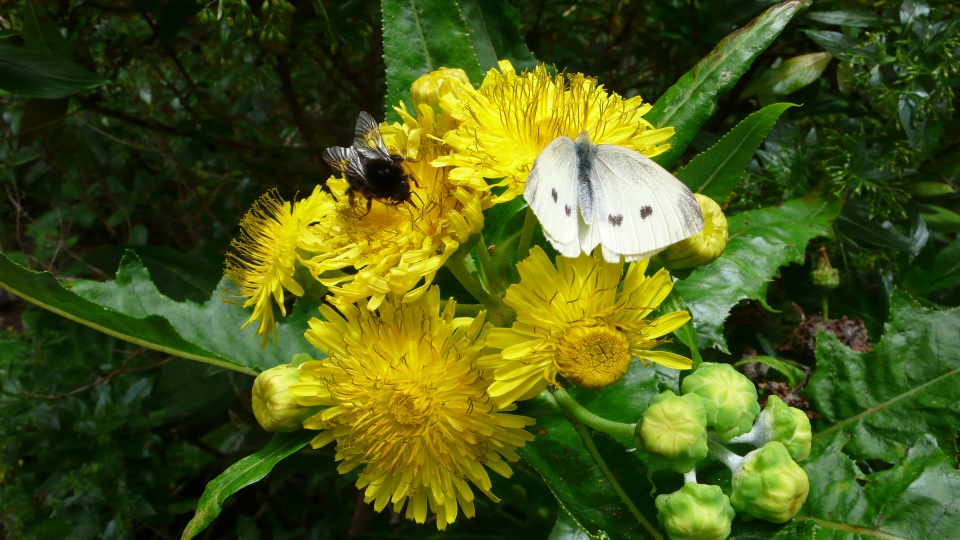
In a new review paper that’s just been published in the Annual Review of Ecology, Evolution and Systematics I have looked at the question of just how diverse the pollinators are, and why pollinator biodiversity is ecologically important and therefore worthy of conservation. I’ve taken a deep time and wide space approach to this, starting with what the fossil record tells us about when animal pollination evolved and the types of organisms that acted as pollinators in the past (the answer may surprise you if you’re unfamiliar with the recent paleontological literature on this topic). Some of the most prominent biogeographical patterns have been highlighted, and I have tried to estimate the global diversity of currently known pollinators. A conclusion is that as many as 1 in 10 described animal species may act as pollen vectors.
As well as this descriptive part of the review I’ve summarised some recent literature on why pollinator diversity matters, and how losing that diversity can affect fruit and seed set in natural and agricultural contexts. Extinction of pollinator species locally, regionally, and globally should concern us all.
Although I was initially a little worried that the review was too broad and unfocused, having re-read it I’m pleased that I decided to approach the topic in this way. The research literature, public policy, and conservation efforts are currently moving at such a fast pace that I think it’s a good time to pause and look at the bigger picture of what “Saving the Pollinators” actually means and why it’s so important. I hope you agree and I’d be happy to receive feedback.
You can download a PDF of the review entitled Pollinator Diversity: Distribution, Ecological Function, and Conservation by following that link.
Pollination ecologists should also note that in this same volume of Annual Review of Ecology, Evolution and Systematics there’s a review by Spencer Barrett and Lawrence Harder called The Ecology of Mating and Its Evolutionary Consequences in Seed Plants. If you contact those authors I’m sure they’d let you have a copy.

I look foward to reading your review:-)
I assume that, due to their importance to the food supply, there is a weight of research funding going into pollinators, but I hope that there is also due concern being paid, for the wild plants that depend on physical distribution of seeds by animals and insects that are vanishing as fast as the pollinators?I look forward to reading your paper. (y)Steve Hawkins From: Jeff Ollerton’s Biodiversity BlogSent: Saturday, 11 November 2017 10:22To: steve.a.hawkins@ntlworld.comReply To: Jeff Ollerton’s Biodiversity BlogSubject: [New post] Pollinator biodiversity and why itâs important: a new review just published â download it for free
a:hover { color: red; } a { text-decoration: none; color: #0088cc; } a.primaryactionlink:link, a.primaryactionlink:visited { background-color: #2585B2; color: #fff; } a.primaryactionlink:hover, a.primaryactionlink:active { background-color: #11729E !important; color: #fff !important; }
/* @media only screen and (max-device-width: 480px) { .post { min-width: 700px !important; } } */ WordPress.com
jeffollerton posted: ”
In a new review paper that’s just been published in the Annual Review of Ecology, Evolution and Systematics I have looked at the question of just how diverse the pollinators are, and why pollinator biodiversity is ecologically important and therefore wo”
Yes, you’re right, much of the research funding is due to the importance of pollinators for food security. But the crop pollinators are generally also important pollinators of wild plants too.
Pingback: Unseen Pollinators | Bad Beekeeping Blog
I love it! Favourite quote: “…the recent description of an asclepiad (Apocynaceae: Asclepiadoideae) flower from Dominican amber together with its termite pollinator, is both a paleontological first and a tantalizing glimpse into a vanished world of unpredicted interactions”
Thank you 🙂
Impressive Jeff. If we’re doing favorite quotes, mine (thus far):
In contrast, natural range contractions are more rarely considered, in part because of a hubristic tendency to assume that any local decline of a species must have an anthropogenic cause, which is clearly nonsensical: The fossil record tells us that species come and go across whole regions at a range of timescales.
Still not finished – on the lookout for pollinator ecology of great ape species. Have several photos I could send you of a particularly ambulatory hominid species pollinating a wide range of plant species in a whole host of habitats.
And one might also suspect this particular species of ape could one day require some conservation effort… 🙂
Oh, thanks much for your efforts to make this review ‘open access’…
Thanks Clem, glad you liked it. Yes, I could have added H. sapiens to Table 1 – would have been interesting to see if the reviewers had spotted it 🙂
I see in Table 1 you do list nonflying mammals… did we get disqualified because of the Wright Brothers?
Pollination and Pollinators; Pollination is the matter for food security to entire World People. The importance of pollinators conservation is prime most important one because they also acting as a Ecological Indicator…
Pingback: There ain’t no b(ee) in Starbucks | Jeff Ollerton's Biodiversity Blog
Pingback: When scientists get things wrong: is coffee the second most valuable global commodity? | Jeff Ollerton's Biodiversity Blog
Pingback: Recent reviews in pollination biology: an annotated list | Jeff Ollerton's Biodiversity Blog
Pingback: The other pollinators: some recent videos that don’t focus on bees | Jeff Ollerton's Biodiversity Blog